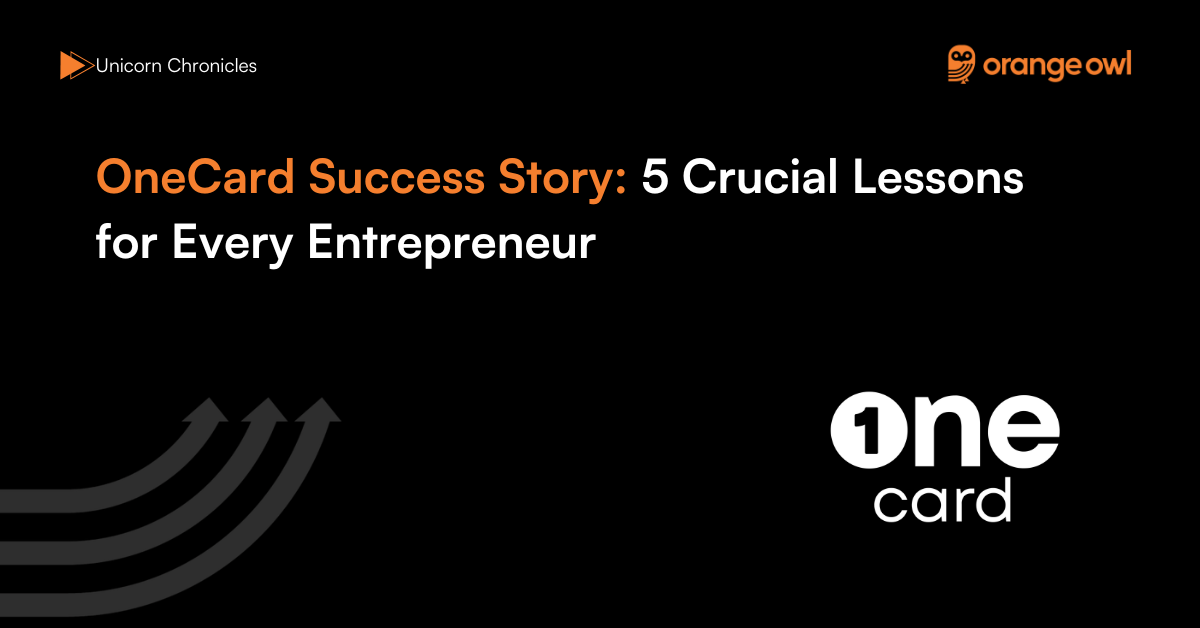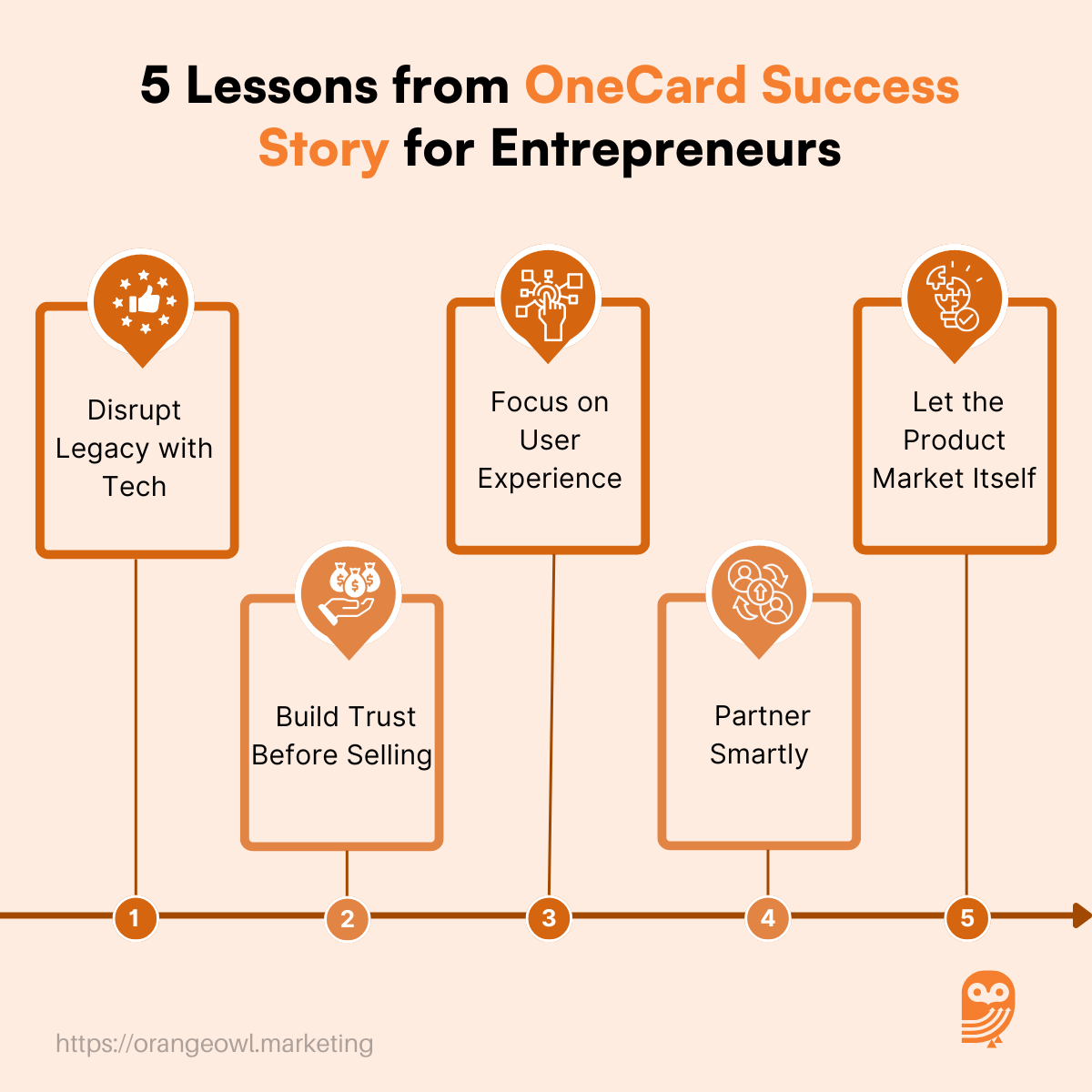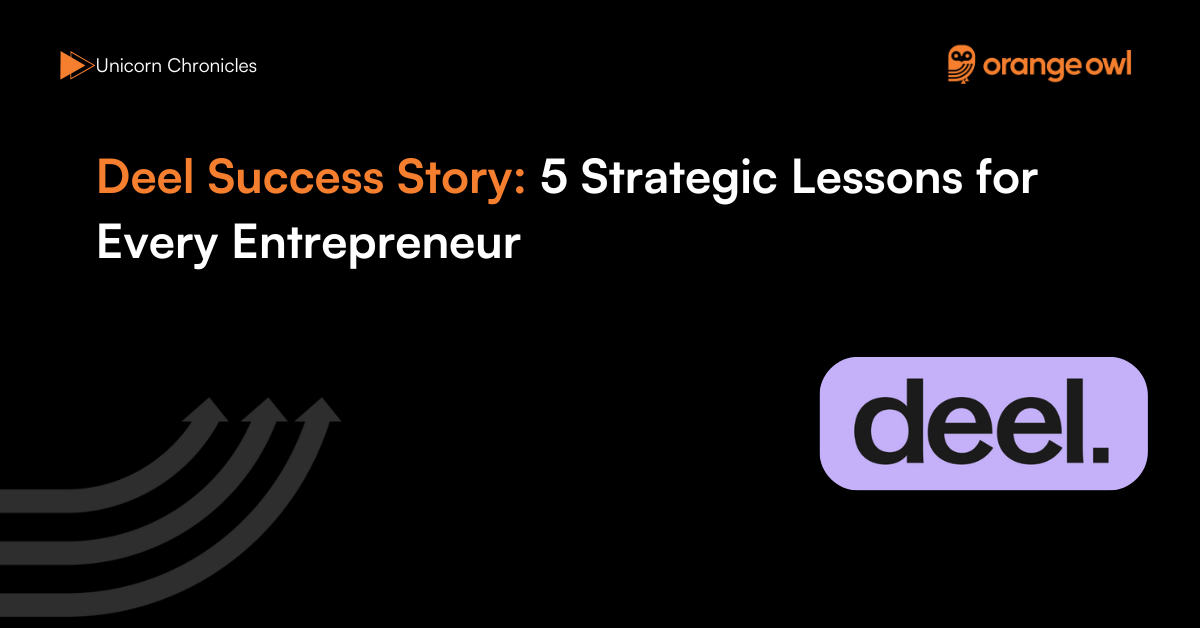OneCard Success Story: 5 Crucial Lessons for Every Entrepreneur
Vivek Goel
May 8, 2025

Table of Contents
Introduction
In India’s rapidly evolving credit card landscape, OneCard has distinguished itself by reimagining the credit experience for the digital-first generation. Launched in 2019 by the founders of FPL Technologies—Anurag Sinha, Rupesh Kumar, and Vibhav Hathi—OneCard offers a sleek metal credit card designed for tech-savvy consumers who value simplicity, transparency, and complete control over their finances via a mobile-first interface.
OneCard’s unique proposition of a no-hassle, app-controlled credit card resonated deeply with users frustrated by traditional banking experiences. With its minimalist design and cutting-edge tech stack, OneCard quickly scaled, becoming one of the fastest-growing fintech products in India. In July 2022, the startup achieved unicorn status after raising $100 million in a funding round led by Temasek, taking its valuation over $1.4 billion.
“Credit cards haven’t evolved much in the last 30 years, and people still receive paper statements. We saw this as a massive opportunity to change things.”
— Anurag Sinha, Co-founder & CEO, OneCard
By 2023, OneCard’s operating revenue surged to ₹541 crore, a nearly 6.5-fold increase from the previous fiscal year, highlighting its rapid growth and market acceptance. This impressive trajectory underscores OneCard’s commitment to innovation and its ability to meet the evolving needs of modern consumers.
Origin Story
The journey of OneCard traces back to the shared experiences of its three founders — Anurag Sinha, Rupesh Kumar, and Vibhav Hathi — all of whom had spent years navigating India’s banking and credit ecosystems. They consistently observed a fundamental problem: credit cards in India were outdated, opaque, and frustrating to use. From sluggish onboarding processes to confusing terms and poor digital interfaces, the system was long overdue for disruption.
“The idea was to build a credit card platform from the ground up — one that gives users control, transparency, and a great user experience.”— Vibhav Hathi, Co-founder, OneCard
In 2019, they launched FPL Technologies, beginning with OneScore, a digital tool that allowed users to monitor and understand their credit scores with ease. This early product wasn’t just about solving a consumer problem; it was a strategic move to build credibility, learn user behavior, and gather data. The traction from OneScore provided the perfect launchpad for OneCard, which debuted later that year.
The founders’ deep domain knowledge and insight into regulatory frameworks gave them a significant edge. Their vision was not just to create another credit card, but to rebuild the entire credit card experience for modern users — focusing on app-first convenience, clarity, and control. This foundation set OneCard apart from legacy financial products right from inception.
Business Landscape and Challenges
When OneCard launched, the Indian credit card market was both promising and challenging. While India had over 1 billion debit card users, credit card penetration remained below 3%, far lower than mature markets like the U.S., where it was over 30%. This presented a massive opportunity — but one that came with significant obstacles.
Most credit cards were distributed by legacy banks, deeply entrenched in traditional systems with cumbersome customer journeys and limited personalization. In contrast, the OneCard team wanted to build a sleek, intuitive, tech-powered product — but doing so meant building infrastructure from the ground up, including underwriting, KYC, credit scoring, customer support, and real-time transaction processing.
“We built our own stack — credit, KYC, customer service, everything — and then integrated with bank partners. That gave us full control over the user journey.” — Rupesh Kumar, Co-founder, OneCard
To solve the compliance challenge while retaining user control, OneCard opted for a co-branded partnership model, teaming up with regulated banks such as SBM Bank India, South Indian Bank, and others. These alliances allowed them to operate within RBI regulations while delivering a seamless, digitally native user experience.
Overcoming skepticism among first-time credit card users and earning their trust was another hurdle. OneCard tackled this with transparent, app-based onboarding, clear fee structures, and no hidden charges — creating a product that felt more like a consumer tech app than a traditional financial tool. This tech-first, user-focused approach enabled OneCard to differentiate itself quickly in a cluttered market.
Growth Strategies
OneCard’s impressive growth trajectory can be attributed to its sharp focus on product-led innovation, data intelligence, and smart partnerships. At the heart of its strategy was the app-first approach, which empowered users to take full control of their credit journey — from tracking spending and managing EMIs to adjusting card settings and locking/unlocking features, all with a few taps on their smartphones.
This seamless digital experience stood in stark contrast to the clunky interfaces offered by traditional banks. Additionally, the team leveraged deep insights from their OneScore user base to build a data-driven underwriting system. By targeting individuals with solid credit profiles, they ensured higher approval rates while mitigating default risks — a critical success factor in the unsecured lending space.
Rather than pursuing an NBFC license from the outset, OneCard adopted a strategic co-branded partnership model by collaborating with trusted banking institutions like SBM Bank and South Indian Bank. This allowed them to remain compliant with RBI guidelines while simultaneously tapping into the banks’ infrastructure and customer base.
Visually, OneCard also broke conventions with its minimalist, metal design — a numberless card that exuded sophistication and aligned perfectly with the lifestyle aspirations of young, tech-forward consumers. As Co-founder Anurag Sinha noted, “For us, it was never just about giving a credit card — it was about giving power back to the user.” Today, OneCard boasts over 1.5 million users and continues to expand rapidly across both Tier 1 and Tier 2 Indian cities, proving the strength of its thoughtful and scalable growth blueprint.
Marketing Strategy
Unlike many fintech players that rely heavily on paid advertising, OneCard took a fundamentally different route — one grounded in organic, user-led growth and a strong sense of brand identity. The core of their marketing strategy was to let the product speak for itself. A satisfied customer became the most powerful ambassador, and word-of-mouth referrals played a critical role in driving adoption.
The card’s exceptional user experience and sleek design created a natural “wow” factor that users couldn’t resist sharing with friends and family. Instead of pushing hard on traditional marketing, the team partnered with fintech influencers and creators on YouTube who could credibly explain the product to a relevant, finance-aware audience.
Another pillar of their strategy was education through OneScore, which not only provided credit insights but also nurtured financial literacy among users. This established trust and positioned OneCard as a brand that genuinely cared about user empowerment. Meanwhile, their distinctive visual branding — particularly the premium, numberless metal card — became a recognizable icon, reinforcing OneCard’s positioning as a product that was both aspirational and functional.
As Co-founder Vibhav Hathi explained, “We never pushed the card aggressively. We let the product speak. That built authenticity.” By staying true to this product-first and design-driven ethos, OneCard was able to achieve sustainable, low-cost customer acquisition while steadily building a loyal and engaged user base.
5 Crucial Lessons Every Entrepreneur Should Learn from OneCard
1. Disrupt Legacy with Tech
OneCard’s core innovation lies in reimagining the decades-old concept of credit cards for the mobile generation. While most players made incremental tweaks to legacy systems, OneCard boldly rebuilt the credit experience from scratch using modern technology.
From instant digital onboarding to real-time transaction controls and EMI conversions via a smartphone, OneCard proved that even the most traditional financial products could be reinvented with a tech-first approach. This lesson is especially relevant for entrepreneurs tackling industries burdened with outdated systems — innovation doesn’t always mean creating something entirely new; it can also mean transforming the old.
2. Build Trust Before Selling
Before launching OneCard, the founders first released OneScore — a free credit score tracking app with no ads, spam, or pushy selling. This strategic move earned user trust in an ecosystem where financial products are often met with skepticism.
By offering real value upfront and respecting user privacy, they created a solid foundation for OneCard’s eventual launch. “OneScore wasn’t a product for profit. It was a trust-building step. That made OneCard’s entry credible,” shared Anurag Sinha. Entrepreneurs can learn that building a long-term brand sometimes requires offering value without immediate returns — trust, once earned, compounds.

3. Focus on User Experience
OneCard’s obsession with simplicity and design is evident in both the app interface and the physical card. Every interaction was designed to feel effortless — from swiping through statements to freezing the card with a tap.
The metal card itself, numberless for security and aesthetics, became a symbol of modern financial empowerment. This attention to UX helped OneCard stand out in a market crowded with offers and jargon. For entrepreneurs, this reinforces the idea that design and speed are not luxuries — they’re core to product success in a user-driven world.
4. Partner Smartly
Instead of applying for an NBFC license or becoming a full-stack bank, OneCard chose to partner with regulated banking institutions like SBM Bank and South Indian Bank. These partnerships allowed them to navigate India’s strict financial regulations while retaining end-to-end control over the customer journey through their proprietary tech stack.
This smart approach reduced time to market, ensured compliance, and built mutual credibility. The takeaway? Strategic partnerships can be far more efficient than trying to own the entire value chain — especially in regulated sectors.
5. Let the Product Market Itself
OneCard’s marketing success came not from flashy campaigns, but from building a product people wanted to talk about. The card’s sleek design, frictionless onboarding, and high app ratings led to organic buzz and strong referral loops.
As Vibhav Hathi noted, “We never pushed the card aggressively. We let the product speak. That built authenticity.” Entrepreneurs should remember that when the product truly solves a pain point and delights users, those users become your best marketers — reducing the need for heavy advertising and lowering CAC in the long run.
Conclusion
OneCard’s journey from an idea to a billion-dollar fintech brand illustrates how deep customer insight, technological reinvention, and strategic execution can disrupt even the most established sectors. In a market dominated by legacy banks and credit institutions, OneCard stood out by challenging the status quo — offering a product that was sleek, intuitive, and designed for the digital age. The team’s prior experience in financial services, coupled with their commitment to design, trust, and user empowerment, laid the foundation for a powerful and scalable product.
What makes OneCard’s success especially compelling is its deliberate and sustainable path to growth. By launching OneScore first to build credibility, partnering wisely with banks to navigate regulation, and relying on organic user love rather than expensive ad campaigns, OneCard demonstrated that product-led growth is not just theory — it works. As the company expands into new geographies and financial services, its playbook offers a roadmap for how modern startups can win in crowded, regulated markets.
“We believe in building products that speak for themselves — not ones that scream for attention,”— Anurag Sinha, Co-founder & CEO, OneCard.
For aspiring entrepreneurs, OneCard’s story is a reminder that innovation, when paired with empathy and execution, can create extraordinary impact — even in the most traditional industries.


